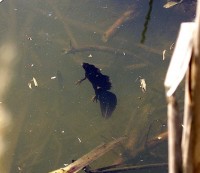As a child I was fascinated by the colorful world of newts. These relatives of frogs spend the spring and summer in the water of ponds and pools to mate and lay eggs there. The males then look like little water dragons with their jagged back combs.
At that time we were boys we were allowed to catch a few newts and put them in an aquarium. Today this is prohibited out of endangered species protection considerations. One of my aquarium guests, a great crested newt from Upper Austria, had lost half the tail and the left foot in combat with a predator. During the time in my aquarium I could watch how both the tail and the foot with all its toes regenerated completely. The wounds remained there open until everything was complete. No scar was left behind – fascinating!
Now a research group from China isolated a peptide from the skin of a newt which is ascribed an important role in this self-healing ability of the newts. It’s called tylotoin and acts similar to the epidermal growth factor (EGF), a growth factor we use for skin treatments for a long time.
Tylotoin stimulates the proliferation of skin cells, connective tissue cells and blood vessel cells. Furthermore, it leads to the release of tissue hormones and cytokines such as transforming growth factor β1 (TGF-β1) and interleukin 6 (IL-6), which play an important role in wound healing.
At present, the wound treatment with autologous mesenchymal stem cells seems very promising and a number of doctors around the world are investigating and performing this therapy. However, at the moment no completely scar-free healing is possible with stem cell application.
Could peptides like tylotoin soon make wounds heal completely without scarring or bring even entire limbs to regenerate? I will keep you up to date,
DDr. Heinrich, MD
